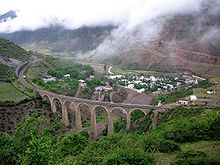The Trans-Iranian Railway (Persian: راهآهن سراسری ایران) is a railway connecting the Persian Gulf with the Caspian Sea through Iran. In 2021 it was added to the UNESCO World Heritage List.
Understand
[edit]
Construction of the Trans-Iranian Railway was begun in 1927, and completed in 1938 under the direction of Reza Shah. It was entirely built with indigenous capital, and linked the capital Tehran with Bandar Shahpur (now Bandar-e Emam Khomeyni) on the Persian Gulf in the south and Bandar Shah (now: Bandar Torkaman) on the Caspian Sea in the north, via Ahvaz and Ghom.
This first section is 1,394 km long. It was an impressive feat undertaken by the Iranian government and foreign contractors because of its scale, and because of the engineering works required to overcome steep routes and other difficulties. The railway required extensive mountain cutting in some areas, and the rugged terrain required the construction of 174 large bridges, 186 small bridges and 224 tunnels, including 11 spiral tunnels.
In 1961, under Reza Shah's son Mohammad Reza Pahlavi, it was extended from Bandar Shah to a new terminus in Gorgan. In 1963, the Trans-Iranian railway was extended to link Tehran to Mashhad, Tabriz and Isfahan.
The original 1938 Bandar Shahpur-to-Bandar Shah route was designated as a UNESCO World Heritage Site in July 2021.
Prepare
[edit]Get in
[edit]Go
[edit]The railway runs roughly north-east from:
- Bandar-e Eman Khomeyni (formerly Bandar Shahpur)
via
to
- Bandar Torkaman (previously Bandar Shah).

